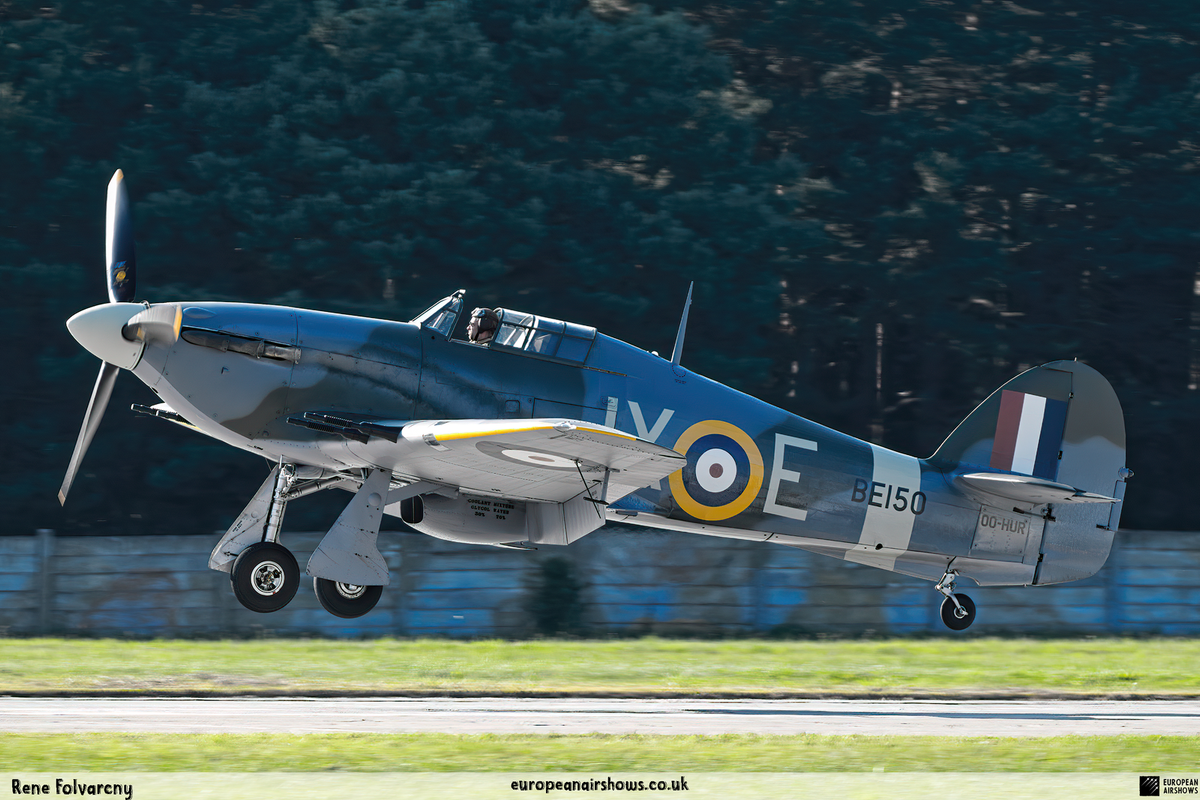
Hawker Hurricane OO-HUR
About the Aircraft
The Hawker Hurricane was a pivotal British single-seat fighter aircraft developed in the 1930s by Hawker Aircraft Ltd. Designed by Sir Sydney Camm, the Hurricane emerged from discussions with Royal Air Force (RAF) officials who sought a modern monoplane to replace the existing biplanes. Initially met with institutional resistance favoring biplane designs, Hawker persisted, incorporating innovative features such as retractable landing gear and the powerful Rolls-Royce Merlin engine. The first prototype, Hurricane K5083, took flight on November 6, 1935, and after successful trials, the RAF placed an initial order in June 1936. Production rapidly scaled up, with the Hurricane entering squadron service by December 1937, benefiting from straightforward construction methods that facilitated extensive maintenance and repair capabilities within RAF squadrons.
The prototype NA-73X was introduced on September 9, 1940, and flew for the first time on October 26, just 102 days after the contract was signed. Originally equipped with the Allison V-1710 engine, the Mustang struggled with high-altitude performance, leading the RAF to utilize it primarily for tactical reconnaissance and as a fighter-bomber (Mustang Mk I).
During the Second World War, the Hawker Hurricane played a crucial role across all major theatres of combat. Despite being overshadowed by the Supermarine Spitfire in popular memory, the Hurricane was responsible for inflicting approximately 60% of the Luftwaffe’s losses during the Battle of Britain in 1940. Its robust design, reliability, and ease of maintenance made it indispensable for both defensive dogfighting against German aircraft like the Messerschmitt Bf 109 and various offensive operations. The aircraft’s versatility was further demonstrated through numerous variants, including bomber-interceptors, fighter-bombers, and ground-attack models. Additionally, the Sea Hurricane variant was adapted for naval use, incorporating features such as arrestor hooks for carrier operations, underscoring its adaptability to different combat environments.
The Hurricane underwent continuous development throughout the war, resulting in over 14,487 units produced in Britain, Canada, Belgium, and Yugoslavia by July 1944. Significant manufacturing contributions came from Hawker, the Gloster Aircraft Company, and Canadian Car and Foundry, among others. In Canada, under the leadership of Elsie MacGill, the Canadian Car and Foundry facility became a major producer, ensuring a steady supply of Hurricanes to the RAF and other Allied forces. The Hurricane’s design was progressively enhanced with metal-covered wings, improved armaments, and more powerful engines, addressing earlier limitations and expanding its operational capabilities. Its enduring presence in the RAF and other air forces throughout the war demonstrated the Hurricane’s essential role in achieving air superiority and supporting ground operations, cementing its legacy as one of the most significant fighter aircraft of World War II.
Specifications
Crew
1
Length
32 ft 3 in (9.83 m)
Wingspan
40 ft 0 in (12.19 m)
Height
13 ft 1.5 in (4.001 m)
Max Speed
340 mph (550 km/h, 300 kn)
Range
600 mi (970 km, 520 nmi)
Service Ceiling
36,000 ft (11,000 m)
Rate of climb
2,780 ft/min (14.1 m/s)
Hurricane Mk.IV
The Hurricane Mk.IV represented the latest significant evolution of the Hawker Hurricane fighter aircraft during the Second World War. Introduced in late 1942, the Mk.IV variant was distinguished by the implementation of the “universal wing,” a versatile design that allowed mounting a variety of armaments and equipment. This adaptability enabled the Mk.IV to carry two 250 or 500-pound bombs, two 40 mm Vickers S guns, two 40 mm Rolls-Royce B.H. type guns, small bomb containers (SBC), smoke curtain installations (SCI), two 45 or 90-gallon drop tanks, or eight “60 pounder” RP-3 rockets. Additionally, two .303 inch Browning machine guns were fitted to facilitate the aiming of the heavier armaments, enhancing the aircraft’s versatility across different combat roles.
Despite the extensive modifications in armament and equipment, the Hurricane Mk.IV retained the same Rolls-Royce Merlin XX engine as its predecessor, the Mk.II, dispelling persistent rumors of engine upgrades. The Mk.IV featured a deeper and armored radiator, as well as additional armor surrounding the engine, which improved its survivability in combat. These enhancements ensured that the Mk.IV maintained reliability and effectiveness even as newer German fighters emerged. The universal wing system not only provided operational flexibility but also simplified maintenance and repairs, allowing RAF squadrons to quickly adapt their aircraft to meet varying battlefield requirements without extensive modifications.
Production of the Hurricane Mk.IV was undertaken primarily by Hawker Aircraft Ltd., with a total of 524 units built between December 1942 and March 1944. This production run marked the culmination of the Hurricane’s development, incorporating lessons learned from earlier variants to address the evolving demands of wartime aerial combat. The Mk.IV played a crucial role in various theaters of the war, continuing the Hurricane’s legacy of reliability and adaptability. Its introduction helped sustain the RAF’s fighter capabilities during a period of intense aerial conflict, ensuring that the Hurricane remained a valuable asset alongside more advanced aircraft such as the Supermarine Spitfire. The Mk.IV’s contributions underscored the importance of iterative design improvements in maintaining air superiority and supporting ground operations throughout the conflict.
Did You Know?
- Although the Supermarine Spitfire often receives more recognition, the Hawker Hurricane was responsible for 60% of the Luftwaffe’s losses during the Battle of Britain.
- The Hurricane was one of the first fighter aircraft to incorporate retractable landing gear and the powerful Rolls-Royce Merlin engine, which were critical innovations for wartime fighters.
- Over 14,487 Hurricanes and Sea Hurricanes were produced by the end of production in July 1944, with significant contributions from manufacturers in Britain and Canada.
- The Hurricane wasn’t just a fighter; it was also developed into various roles including bomber-interceptors, fighter-bombers, and ground support aircraft, adapting to the changing needs of WWII.
- The Sea Hurricane variant was modified with an arrestor hook and other features to operate from aircraft carriers, earning the nickname “Hurricats” among the Fleet Air Arm pilots.
Test Your Knowledge
1. When did the prototype Hurricane K5083 have its maiden flight?
Hurricane Mk.IV OO-HUR
The Hurricane Mk.IV OO-HUR has a storied past that spans several decades and countries. Built in 1943, this aircraft was initially issued to the RAF No. 6 Squadron, where it saw combat in various theaters, including Italy, Greece, and Yugoslavia. After World War II, it continued its service in Nicosia and Palestine before being abandoned in 1947 in what is now Israel.
Fast forward to 1983, when the aircraft was discovered in a scrapyard in Jaffa by aviation enthusiast Doug Arnold. He brought it back to the UK, where it was registered as G-HURY in 1991. However, significant restoration efforts didn’t begin until 2001, after it was acquired by Stephen Grey’s The Fighter Collection. Hawker Restorations took on the project, and after a successful restoration, OO-HUR took to the skies again in 2003.
In early 2006, the Hurricane was sold to Vintage Wings in Canada and shipped to Montreal. On June 9, 2006, it received a Canadian Certificate of Airworthiness under the registration CF-TPM. During its time in Canada, the aircraft changed ownership a few times before being put up for sale in 2018.
On August 13, 2018, OO-HUR was registered with the Belgian Civil Register. After reassembly by the Fast Aero team in Brasschaat, it made its first flight in Belgian airspace on November 4, 2018, and settled at Deurne Airport.
The aircraft underwent a transformation and made its first flight in a new livery on May 20, 2021, before being flown to its new home at the Aviation Museum in Tocna, near Prague, Czech Republic.
Tragically, on August 14, 2022, during a display at the Aviation Days in Cheb, the Hurricane crashed, resulting in the untimely death of the pilot. This incident marked a somber end to the aircraft’s remarkable journey through history.
Inactive Status
The aircraft crashed during a display in August 2022, resulting in the tragic death of the pilot


